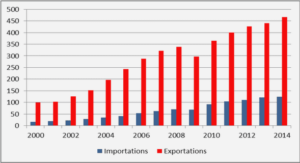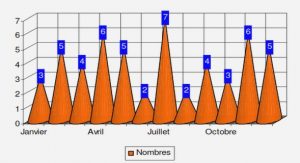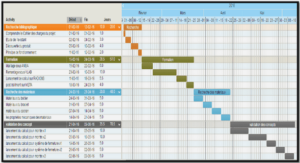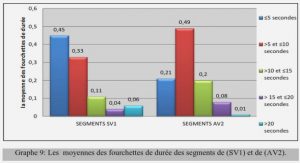Assessing the impacts of climate change on women’s poverty: A Bolivian case study
Abstract: Climate change affects men and women differently, and pre-existing gender disparities may worsen. We use a gendered computable general equilibrium model linked with microsimulations to assess the distributive effects of climate change in Bolivia. Two scenarios are evaluated. The first scenario addresses capital and land damages, while the second analyses the decrease in agricultural production yields. We find that both scenarios have negative impacts on the Bolivian economy. The scenarios drive down employment and increase the burden of domestic work, especially for women. Furthermore, both simulations reveal negative impacts on poverty, with women in rural areas being the most affected.
Model and data
CGE Model
To evaluate the impacts of climate change on women’s poverty, we use the static Partnership for Economic Policy (PEP 1-1) standard model by Decaluwé et al. 2013. However, to better represent the Bolivian features, the standard model has been modified in many ways , as presented below.
In line with the social accounting matrix (SAM), the model has 20 activities and commodities. The production function technology presupposes constant returns to scale presented in a four-level production process. At the first level, production is a Leontief type of function of value added and intermediate consumption. At the second level, a CES function is used to represent the substitution between composite labour and composite capital. At the third level, composite labour is further disaggregated by skills (skilled and unskilled workers) following a CES type of function, while composite capital is a CES function of capital and land for agricultural sectors only. At the fourth level and for each skill category, the labour demand is a CES function between male and female workers. To reflect the fact that men and women are not easily substitutable, we use low elasticity of substitution values as in Fontana and Wood (2000) and Fofana et al. (2003). These values are set at 0.5 and 0.7 for skilled and unskilled workers.
The model distinguishes four different institutions: households, firms, the government and the rest of the world. Households are also disaggregated by gender and location: maleheaded households in rural and urban areas and female-headed households in rural and urban areas. These households have three different sources of income: labour, capital and transfers from other agents. The income of male-headed households comes mainly from labour in both rural (89%) and urban (84%) areas. In female-headed households, income from labour is also the main source of revenue but to a lesser extent than that of male-headed households. Transfers also constitute an important part of household income, mainly in female-headed households where transfers account for 22% and 23% of income in both rural and urban areas, respectively, while in male-headed households, transfers account for only 10% and 13% of income in rural and urban areas, respectively. Finally, households receive income from capital and land.
Although this source accounts for the smallest share of total income, it should be noted that urban households receive the largest share: more than 90% of this income is earned by urban households.
All categories of households use their income for tax payments, savings, and mainly for consumption, which is specified with a linear expenditure system (LES) type of function (Stone, 1954). Finally, savings account for between 8% and 13% of total household income, with urban households making the most (12.4% in male-headed households, 12.7% in female-headed households).
Firms’ income is based on transfers from other institutions and mainly on capital income. They pay income taxes and dividends, and the remaining income constitutes firms’ savings. The government collects direct taxes from households and firms and indirect taxes (import duties, taxes on commodities and taxes on production) and receives transfers from other agents. These resources are used for public expenditure (mainly on nontradable commodities)and for the payment of transfers to nongovernmental agents. The remainder constitutes savings. Bolivian workers allocate a significant part of their time to domestic activities, which prevents them from earning money. Indeed, women devote 23.5% of their daily 24 hours to doing unpaid household and care work, while men devote only 12.6% of their time to this work (CEPAL, 2001). In rural areas, the difference is even more striking, with women spending 7 hours per day on domestic chores compared to 1.4 hours for men (Ashwill et al., 2011). To complete the allocation estimates on the use of time and given the absence of disaggregated data per level of qualification in Bolivia, we used the Colombian time allocation estimates from Rubiano-Matulevich and Viollaz (2019). Based on these studies, Bolivian unskilled women allocate 5.47 hours per day for domestic work, while skilled women allocate 4.1 hours per day.
Unskilled men allocate 1.25 hours per day for domestic chores and skilled men allocate 1.23 hours.
Most CGE studies concerned with modelling in the non-market sphere propose the extension of gender SAMs to include domestic work and leisure as new sectors (Cockburn et al., 2007; Fontana, 2004; Fontana & Wood, 2000; Siddiqui, 2009). However, given the lack of information to correctly introduce Bolivia’s non-market sectors into the SAM, we use an alternative modelling framework that relies on the introduction of explicit labour supply functions determined by households (Fofana et al., 2003, 2005; Terra et al., 2009). Moreover, as in Terra et al. 2009, we include differences by skill level in the CGE model, in addition to the gender differences integrated in Fofana et al., (2003, 2005).
Technically and based on Fofana et al. (2003), we consider that households have a fixed amount of time (measured in hours) that they can allocate between paid work in the market sphere, leisure, and the production of a nonmarket commodity (taking care of the kids, fetching water, etc.). Therefore, households maximise their utility under the constraint of their full income, which is the sum of the different incomes from both the market sphere of the economy (labour income, land income, transfers from other agents, etc.) and the non-market spheres (home production).
Then, the time devoted to the non-market sphere creates a new commodity called “home-produced commodities”, which is made up only by labour and fully consumed by households. Moreover, the value of these commodities is equal to the value of the labour used in their production, where nonmarket labour is priced at its opportunity cost, as measured by the market wage rates. The production function of the “home-production commodity” follows a CES type of function with a low elasticity of substitution between male and female labour. In terms of closure rules, Bolivia is a small economy; therefore, world prices are exogenous. In addition, the Bolivian current account balance and government expenditure on goods and services are assumed to be fixed. Similarly, all tax rates (direct, indirect, import, production) are fixed. We assume that capital is sector specific, while labour is mobile across sectors. The nominal exchange rate is the numeraire.
Finally, to assess the distributional impacts, we use a top-down approach that links the CGE model with a microeconomic analysis module. Specifically, once the macro model is run, changes in the wage rate, income level and prices under climate change scenarios are transmitted to the micro module to calculate changes in poverty. In this specific module, wecompute the FGT indicators from Foster et al. 1984.
Data
The CGE is calibrated on the SAM from IFPRI et al. 2018. It has 20 activities/commodities, nine of which are agricultural activities: cereals, vegetables, tubers, fruit, other nonindustrial agriculture, soybeans, sugar cane, coca and livestock. To implement our climate scenarios, we grouped these 9 agricultural categories into two types of agriculture, traditional and modern, as they will be affected differently. Traditional agricult ure is labour intensive and based on indigenous knowledge and practices, which have been developed over several generations. In the model, this type of agriculture includes the cultivation of cereals, legumes, tubers, fruits and other nonindustrial crops. Modern agriculture is, however, characterised by the integration of technology and includes the cultivation of crops such as soybeans, sugar cane and coca. Likewise, Bolivian agricultural production is mainly destined for the local market, with only 12% of agricultural production exported. Modern crops are, however, exported more than traditional crops (58% vs. 42%). Soybeans are the main agricultural export product (46% of total agricultural exports), followed by cereals, which makeup 25% of total agricultural exports.
The SAM distinguishes three factors of production: capital, land and labour. Land is disaggregated into 3 regions (highlands, valleys and lowlands), and labour is disaggregated according to the level of skills (skilled and unskilled) and gender (male and female). It considers four different institutions: households, firms, the government and the rest of the world. The former is further disaggregated into female/male headed households and whether they live in rural or urban areas. Next to the SAM, we use income elasticity from Morales et al. 2017 and borrow Armington elasticities from Sevillano Cordero, 2012.
To assess the distributional impacts, the micro data we use are based on the National Household Survey (INE, 2019). Although Bolivia has managed to reduce its poverty rate from 59.6% in 2005 to 34.6% of the population in 2018 (WDI, 2018), poverty is still an important issue in Bolivia, as it is still high compared to the rates in neighbouring countries ( CEPAL, 2019). Moreover, poverty is not evenly distributed among men and women, with women experiencing a higher national poverty rate (38% vs. 37%, (INE, 2019)) and rural women experiencing a poverty rate 20 percentage points higher than their urban counterparts (52% vs. 32%, (INE, 2019)).
Scenarios and results
Scenarios
The first simulation is based on an analysis of the direct and indirect effects of the extreme climatic events that occurred in 2013 and 2014 in Bolivia. It considers two different channels: land and capital loss (e.g., machineries, factories) suffered in Bolivia by climatic events (e.g., floods) on one side and world price changes on the other side. We analyse both shocks together since climate change has a global impact on economies, which includes impacts on the evolution of world food prices (Bandara & Cai, 2014; G. C. Nelson et al., 2009). As Bolivia’s main export products are soybeans and cereals, international price variations due to climate change could affect the dynamics of the agricultural sectors.
Specifically, the first simulation considers damage and losses due to climate events in the agriculture sector to be 689.53 million bolivianos (UDAPE, 2015). It was estimated that the damage caused represents losses affecting the land and capital factor of the agricultural sector by 21.9%. To consider the variation in the international prices of agricultural products due toclimate change, we use the study by Nelson et al. (2009), which gives forecasts for some agricultural and livestock products for the years between 2000 and 2050 using the NCAR (National Centre for Atmospheric Research) model based on the A2 scenario of the IPCC report. Specifically, we consider an increase in the world price of 15% for products from the livestock sector and an increase of 17% for soybeans. The latter increase is also applied to coca and sugar crops, as we consider that these are modern agricultural products. We then compute an average price variation for traditional agricultural products such as rice, corn and wheat. An average price increase of 37% is estimated and applied to Bolivian traditional crop products.
In the second simulation, we consider two different channels as well: a reduction in agricultural productivity and a change in world prices for agricultural commodities. To implement the magnitude of the changes in productivity, we use data from Viscarra et al. (2018), who estimate the impacts of climate change on the average yields of certain pr oducts for different scenarios in Bolivia. We take into consideration the impacts corresponding to the IPCC A2 scenario, where an estimated 5% drop in the average yield of soybean production and a 12% drop in the average yields of maize and rice in Bolivia will occur. In the model, we apply the variations in soybean yields to modern crops and the variations in maize and rice yields to traditional crops. For the magnitude of changes in world prices of agricultural commodities, weuse the same variations as in the first simulation.
Results and discussion
Before discussing the results, let us identify the main transmission channels for our two simulations. On the one hand, the damage to both capital and land (Sim 1) and the reduction in agricultural productivity (Sim 2) have a negative impact on agricultural production. On the other hand, with the increase in world prices for agricultural commodities, some Bolivian producers may be interested in exporting their commodity, but most of them may face an increase in their input prices if they were using imported commodities. The impacts on the agricultural sectors will spread to the other sectors of the economy.
Agricultural sectors
As expected, agricultural production decreases by 16% in the first simulation and 5% in the second simulation. Consequently, agricultural sectors reduce their intermediate consumption, which affects other sectors in the economy. In the first simulation, crops such as soybeans and sugar cane are mainly affected due to their high capital and land intensity, while in the second simulation, traditional crops are hit harder.
Specifically, in the first scenario, soybean production, which is the most capital- and land-intensive crop, is the most affected, with production falling by 17%, followed by sugar cane production (-13%). Subsequently, the production of traditional crops (cereals, fruits, vegetables, and root crops) decreased by 10 to 16%, while coca production was the least affected, with a decrease of 4.85%. Concerning the second simulation, the results also show a decrease in agricultural production for all crops. However, contrary to the previous simulation, traditional crops are the most affected this time, with production losses ranging from 5.4% to 7%. Modern crops are affected to a lesser extent, with production losses ranging from 1.1% to 3.6%.
As far as agricultural employment is concerned, the results show an interesting variability between the different types of crops, given differences in the intensity of crops, in capital or labour but also in the intensity between different types of labour. In Bolivia, traditional crops tend to use mostly unskilled labour, while modern crops require higher skill levels and above all capital for their production. In the first simulation, agricultural employment decreases in all sectors. Indeed, the decline in production means that fewer workers are needed.
As a result, agricultural employment falls by 6.34%, with livestock, traditional crops in general and soybeans (to a lesser extent) being the most affected. Given that the livestock and traditional sectors in Bolivia hire mainly low-skilled workers, the employment of unskilled workers registers more severe declines. The second simulation, by contrast, shows some positive employment effects. Indeed, to compensate for productivity losses, some agricultural sectorsemploy additional workers. Employment increases slightly more for traditional crops than formodern ones, as these are the most labour-intensive agricultural sectors.
Non-agricultural sectors
For the nonagricultural sectors, the overall impact on production is negative. In the first simulation, the drop in agricultural production leads to a decrease in intermediate demand, which affects the sectors relying on the agricultural sectors. These sectors will lay off workers. Moreover, the drop in household consumption (see section 3.2.4) has an impact on the production of the different sectors. Specifically, sectors such as the food industry, restaurants and hotels are particularly hit.
Despite a slight increase in agricultural employment in the second simulation, the overall effects on employment are negative (-1.19% in the first simulation and -0.16% in the second simulation). However, the results show substantial differences according to the different types of work and gender
Gendered effects on employment
The negative employment effects are reflected in a lower participation rate of households in the commercial sphere. Our results reveal that the loss of employment in the paid labour market leads to an overall increase in the domestic workload of Bolivian households in both simulations. However, these trends vary considerably by gender, with women being particularly more affected than men.
In the first simulation, women suffer particularly from job losses given their strong presence in the traditional agricultural sectors that are the most affected by the climate scenario.
Indeed, employment in traditional agricultural sectors is reduced by almost 7%. As shown in Table 1.1, the decrease in employment in the commercial market affects mainly unskilled workers, given their overrepresentation in traditional sectors. This reduction is more significant for women in both rural and urban areas than for men and ultimately leads to increases in their domestic burdens.
In the second simulation, the results also reveal employment losses, although in smaller proportions, and unlike the previous simulation, these are explained by the concentration of female labour in the nonagricultural sectors where women are more active. These sectors include livestock, the commercial industry, the textile industry, and the restaurant and hotel industry, where production is contracted, causing a reduction in employment of close to 3%.
Impacts on Poverty
At baseline, poverty is higher for women than for men, especially in rural areas where 55.3% of women are poor (Table 1.2). Compared to this baseline situation, both scenarios lead to an increase in poverty, especially in rural areas. Indeed, in the first simulation, we find an increase in poor households, with women being more affected than men in both rural and urban areas. Among women themselves, women in rural areas suffer greater increases in poverty compared to their urban counterparts. In fact, compared to the baseline scenario, the poverty headcount increases by 2.95 percentage points in rural female-headed households, compared to 1.48 percentage points in their urban counterparts. This will result in approximately 58% of female-headed households being classified as poor. Poorer households are particularly hit in both rural and rural areas, especially female-headed households.
Sensitivity analysis
Thus far, the results suggest that climate scenarios have overall negative effects on the economy and lead to an increase in poverty and gender inequalities. However, the results of CGE models tend to be sensitive to the parameters upon which the model is calibrated (Withey et al., 2016). To test the robustness of our results, we conduct a sensitivity analysis on the parameters assigned for the elasticities of substitution between labour demand, the transformation elasticities assigned on the endogenous labour supply, and the Armington transformation elasticities used between the domestic and the international market. The values assigned to these key elasticities have been increased and reduced by 50%.
The results reveal slight changes for both sensitivity scenarios that do not affect the trends observed in the key variables. Indeed, as shown in Table 1.3, the main macroeconomic variables (employment, consumption, GDP and investment) display negative effects, as do the main microeconomic variables (poverty, inequality), with female-headed households being the most affected. We can therefore conclude that the results are robust since the analysis does not show substantial changes. However, it should be noted that despite not having significant changes in the key variables, when higher elasticity values are used, changes in the key variables tend to be slightly more detrimental to the economy, while lower elasticity values gene rate slightly fewer negative effects. Therefore, a lower restriction of the model (using high elasticities) is somehow more detrimental for women and for the economy as a whole.
Likewise, sensitivity analysis extended to poverty indicators also follows this trend and confirms that the use of higher elasticities makes poverty increase slightly more, especially for rural women.
Data
The main source of data comes from a social accounting matrix (SAM). Specifically, we use the 2012 SAM developed by IFPRI et al. (2015), which offers a regional disaggregation of the agricultural sector (highlands, valleys and lowlands). This aspect is important for the present study, given the different exposures to climate change of the agricultural sectors in the three regions. The initial SAM provided a breakdown of the agricultural sector into nine crops, which were aggregated into three groups representing three types of agriculture (traditional, livestock and modern). Among the regions, the use of agricultural production factors, whether in traditional or modern agriculture, as well as the type and destination of agricultural production, vary greatly according to location.
For instance, the highlands and valleys tend to have a more traditional agricultural production system, while modern agricultural production is predominant in the lowland areas (Column 3 Table 2.1). Bolivian traditional agriculture is labour intensive and based on indigenous knowledge and practices that include the cultivation of cereals, legumes, tubers, fruits and other nonindustrial crops. Conversely, modern agriculture is characterised by the integration of technology and includes the cultivation of crops such as soya, sugar cane and coca. In general, Bolivian agriculture is labour intensive in all regions, with unskilled labour being the main factor, especially in traditional agriculture (Columns 4-6).
|
Table des matières
Introduction générale
Chapitre 1
I. Assessing the impacts of climate change on women’s poverty: A Bolivian case study
1.1. Introduction
1.2. Model and data
1.2.1. CGE Model
1.2.2. Data
1.3. Scenarios and results
1.3.1. Scenarios
1.3.2. Results and discussion
1.3.2.1. Agricultural sectors
1.3.2.2. Non-agricultural sectors
1.3.2.3. Gendered effects on employment
1.3.2.4. Impacts on agents
1.3.2.5. Impacts on Poverty
1.4. Sensitivity analysis
1.5. Concluding remarks
Chapitre 2
II. Climate disaster’s impacts on women and food security in Bolivia
2.1. Introduction
2.2. Review of Previous Work
2.3. Methodological Framework and Data
2.3.1. The CGE model
2.3.2. Food security and food poverty
2.3.3. Data
2.4. Climate Scenario and Results Discussion
2.4.1. Macro results
2.4.2. Sectoral results
2.4.3. Impact on agents
2.4.4. Impact on food security and food poverty
2.5. Sensitivity analysis
2.6. Concluding remarks and policy recommendations
Chapitre 3
III. Climate Disasters, Women and Poverty: Towards Inclusive Disaster Risk Reduction in Bolivia
3.1. Introduction
3.2. Overview of linkages between poverty, gender and climate disasters in Bolivia
3.3. Data and Methodological framework
3.3.1. Data
3.3.2. The Macro-Micro model
3.3.2.1. The dynamic recursive CGE model
3.3.2.2. Institutions in the CGE Model
3.3.2.3. Modelling of climate disasters and reconstruction investment the CGE model
3.3.2.4. Closure rules
3.3.2.5. Microsimulation module
3.4. Scenarios and results
3.4.1. Scenarios
3.4.2. Macro results
3.4.3. Sectoral results
3.4.4. Gendered impacts
3.4.5. Impacts on Poverty
3.5. Concluding remarks and policy implications
Conclusion générale
Bibliographie
Annexes
Appendix A.1 : Annexe du Chapitre 1
Appendix A.2-1 : Annexe du Chapitre 2
Appendix A.2-2 : Calibration of the parameters (and variables) in the equations related to the home production
Appendix A.3 : Annexe du Chapitre 3





